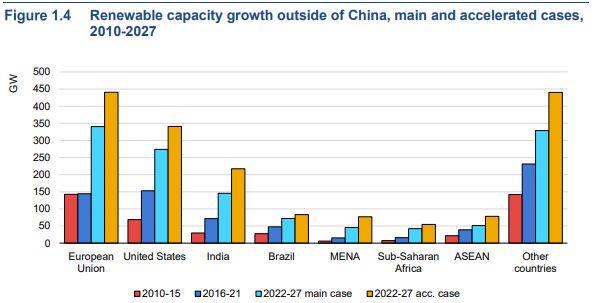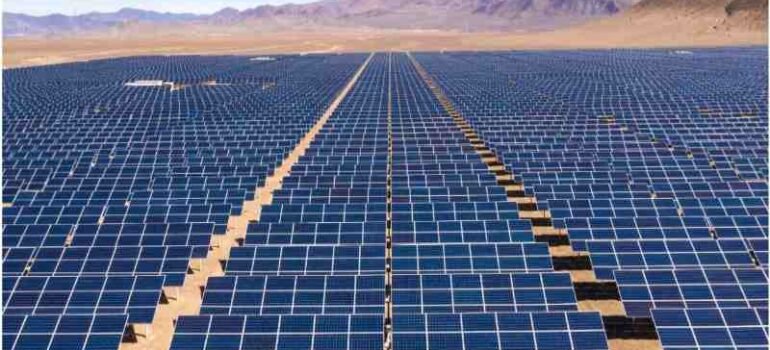Sustainable power is set to become a ubiquitous part of our future through their reliable low-carbon properties enabling consumers to pay less for electricity and mitigate the impacts of climate change. Currently, there are four major sources of renewable energy recognized by the U.S Energy Information Administration as being the main sustainable power producers: biomass, hydropower, geothermal, wind, and solar.
Solar:
By using photovoltaic panels to convert sunlight into energy, solar power makes the most of the Sun’s daily cycle to harvest energy efficiently. A cheap and easy way of providing electricity, solar power is one of the largest forms of sustainable energy available, producing 570 TWh globally in 2018 and on track to expand its capacity up to 50% by 2024. Solar energy has been used to lead an energy transition away from fossil fuels, electrifying rural communities and driving sustainable development.
Low operation costs, low carbon emissions, efficient power production and the rise of batteries has made solar energy a force for utilities companies – even the most reticent to embrace renewables. On top of the utilities sector, the aviation industry has also begun to innovate by using solar energy as a means to reduce their carbon footprint. Investment in solar has continued to increase, with nations like China taking the lead in implementing large-scale solar projects.
This source of energy is becoming one of the most affordable and accessible, owing to years of investment and development within the solar industry. Along with continued innovation within the field of lithium-ion batteries, solar power has become a major source of employment and electrification globally.
Hydropower:
Hydropower is one of the oldest forms of sustainable energy in use, dating back several thousand years, and it has grown to encompass several forms of water-based power generation. The most recognizable form of hydropower comes in the form of dams like the Hoover (USA) or Three Gorges (China), where they produce electricity by letting water flow through its generators downstream. Responsible for 16% of total global energy production, hydropower is currently the world’s largest source of sustainable energy.
Hydropower refers to the use of water’s movement as a medium for energy generation. Including dams, tidal and wave-power, hydroelectricity’s wide range of sources reflect its versatility and ability to be used almost everywhere. A dominant form of sustainable power, hydropower was responsible for 4,200 TWh of energy production in 2018. Featured in the electrical grid of a vast range of countries, hydropower is one of the most mainstream forms of sustainable energy found on the current energy market.
Hydroelectric dams are playing a leading role in Costa Rica’s ability to run almost exclusively on renewable energy while innovation in wave power in Orkney has furthered research in sustainable development. Capable of storing energy through pumped storage facilities, hydropower provides both alternative energy and storage options. Along with other forms of sustainable energy, hydro is expected to increase its capacity and help lead a transition away from fossil fuels.
Wind Power:
Another form of sustainable energy that has been used for millennia, windmills have evolved from grinding grain and pumping water to become wind turbines capable of harnessing large amounts of energy. The large blades that make up the turbine are driven by the wind and power the generator within it to produce energy. One of the fastest growing forms of renewable energy, wind farms can be installed at sea and on land, and have played a major part in the global transition away from fossil fuels.
A form of sustainable energy that has continued to develop and innovate, wind power has gained popularity with utility companies due to its cost-efficient power generation. Installed in areas exposed to high amounts of wind, turbines work by using their large blades to capture the wind’s power and use it to turn a generator, creating energy. In recent years, wind power capacity has greatly increased in Europe, the United States and China, with close to 600MW of installed capacity reported in 2018 – and calls to triple that capacity by 2030.
Able to be installed offshore as well as on land, wind turbines have the ability to generate high amounts of power for coastal communities. New developments in battery storage have reduced the intermittency issues facing wind power, making it one of many sustainable energy options now capable of powering energy grids with more consistency.
Geothermal:
Geothermal energy harnesses the heat generated naturally within the Earth and carried to the surface in the form of steam, which geothermal power plants generate electricity from via drilled wells. Since its first iteration in 1913, geothermal power plants and the technology behind them has been refined and optimized to become an integral part of the power grids of several nations including Iceland, El Salvador and New Zealand.
Used as a means of power and heating for thousands of years, geothermal energy is one of the oldest forms of power available to us. Sourced from the natural heat emanating from the planet’s core, geothermal energy is responsible for a large share of the energy production of countries such as Iceland, Kenya and New Zealand. After the signatories of the Paris Agreement pledged to reduce global carbon emissions, geothermal has been proposed as a reliable form of sustainable energy for a range of nations globally.
With 14,900MW of installed capacity worldwide, geothermal energy is expected to continue its growth, with certain projections believing it could shoulder up to 3.5% of global electricity demand by 2050. As it relies on the Earth’s core temperature for energy, geothermal does not have intermittency issues, but requires more infrastructure to ensure power generation, while questions have been raised about its environmental impacts.
Bioenergy:
A mix of both traditional and modern energy techniques, bioenergy is derived from a vast array of biological materials such as food waste or wood pellets and comes in many shapes and forms. Through either combustion of biological materials to provide energy, or liquid biofuels to power vehicles, bioenergy has been a cornerstone of sustainable development.
Popular in countries with rapidly power demand and growing waste and agricultural sectors, bioenergy has the versatility to provide for different energy needs. As an energy provider, it has a global installed capacity of 130GW, while also helping power vehicles worldwide. Growth in the Pacific and across Africa has seen the use of bioenergy increase steadily as a means to transition away from fossil fuels.







